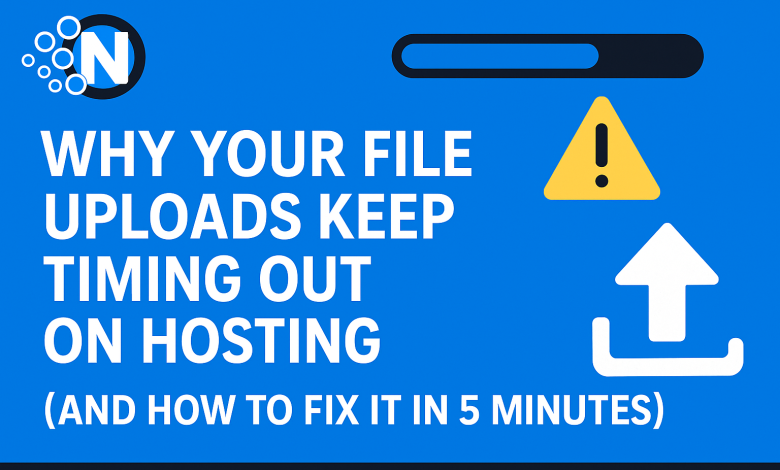Why Your File Uploads Keep Timing Out on Hosting (And How to Fix It in 5 Minutes)

You’re uploading a large video or PDF on your hosting, and just before it finishes, it stops with a timeout error.
That’s frustrating, right?
File upload timeouts are one of the most common problems developers face, especially when dealing with files larger than 10-20 MB.
The good part is that most timeout issues happen for only a few simple reasons, and fixing them is easier than you might think.
In this guide, I’ll explain why file uploads fail and show you practical solutions you can try, even if you’re not an expert coder.
<strong>Key Takeaways</strong>
1. Server timeout limits are the main reason large file uploads fail.
2. Unstable internet connections can interrupt long uploads, causing them to fail.
3. Showing upload progress keeps users informed and reduces frustration.
4. Chunked uploads split large files into smaller parts, making uploads more reliable.
5. Modern upload services can fix most timeout issues with minimal code changes.
Why File Uploads Time Out
Here are some common reasons why file uploads fail:
1. Server Timeout Limits
Most web servers have built-in timeout limits, usually between 30 and 60 seconds. If your upload takes longer than that, the server stops waiting and returns an error.
But why does this happen?
Large files take more time to upload, especially on slower internet connections. For example, a 100 MB video can take several minutes to upload on a normal home network, which can be longer than the server’s default time limit.
2. PHP/Server Configuration Restrictions
If you’re using PHP (or similar server-side languages), your server has limits for uploads:
- upload_max_filesize: Maximum size of a file you can upload.
- post_max_size: Maximum amount of data you can send in a form.
- max_execution_time: How long the server will run the upload script.
- memory_limit: How much memory PHP can use.
The default limits are usually small (2–8 MB), which isn’t enough for large files.
For more details, check the PHP file upload documentation.
3. Network Interruptions
Long uploads can break if your internet drops, even for a moment. Then the upload fails, and users must start again.
4. No Progress Indication
When users see nothing happening, they often refresh the page or click “upload” multiple times. This can stop the upload, and without a progress bar, users can’t tell if the upload is working or stuck.
👉 Tip: Check out MDN’s file API best practices for showing progress and managing large files efficiently.
5. Browser Connection Limits
Browsers only allow a few connections to one website at a time. If your page is sending many requests, the upload may have to wait, which can cause it to time out.
The Traditional Solution (And Why It’s Complicated)
Because of all the above issues, handling large file uploads isn’t simple. The traditional way to fix this takes several steps:
- Increase server timeout limits in .htaccess or php.ini.
- Change PHP settings like upload size and memory.
- Split files into smaller chunks for uploading.
- Allow uploads to resume if interrupted.
- Show a progress bar.
- Handle errors and retry failed uploads.
Even basic chunked upload code can get complex very quickly.
Here’s a simple example of chunked upload:
Upload a File in Chunks
| const uploadFile = async (file) => { const chunkSize = 1024 * 1024; // Split file into 1MB chunks const chunks = Math.ceil(file.size / chunkSize); // Total number of chunks // Loop through each chunk and upload sequentially for (let i = 0; i < chunks; i++) { const start = i * chunkSize; // Start byte of the current chunk const end = Math.min(start + chunkSize, file.size); // End byte (not exceeding file size) const chunk = file.slice(start, end); // Extract the chunk from the file try { // Send chunk to the server via POST request await fetch(‘/upload’, { method: ‘POST’, headers: { ‘Content-Type’: ‘application/octet-stream’, // Binary data ‘X-Chunk-Index’: i, // Current chunk number ‘X-Total-Chunks’: chunks, // Total chunks to help server reconstruct ‘X-File-Name’: file.name // Original file name }, body: chunk // The actual chunk data }); } catch (error) { // Handle failures: retries, progress updates, or error logging console.error(‘Upload failed:’, error); } } }; |
What this code does:
This JavaScript function uploads a large file in small pieces (called chunks) instead of sending the whole file at once.
How it works:
- Splits the file into 1MB chunks using file.slice().
- Loops through each chunk and sends it to the server one by one with a fetch POST request.
- Each request includes headers like:
- X-Chunk-Index: tells the server which chunk this is.
- X-Total-Chunks: tells how many chunks there are in total.
- X-File-Name: tells which file these chunks belong to.
- The server is expected to receive all chunks, keep track of them, and finally rebuild the full file once every piece is uploaded.
The problem with this approach:
This method sounds simple, but it can be hard to manage in real life. Here’s why:
- You need server-side code to keep track of the chunks, put them back together in the right order, and handle incomplete uploads.
- If the connection drops halfway, the user has to start the upload from the beginning instead of continuing where it left off.
- Users won’t know how much has been uploaded unless you add a way to show the progress.
- Each chunk of the file waits for the previous one, so the upload is slower than sending multiple chunks at the same time.
- You need extra code to try again when uploads fail and to deal with timeouts or repeated files.
The Simple Solution
Modern file upload services like Filestack handle all these problems for you.
They automatically manage chunking, retries, progress tracking, and server configuration, so you don’t have to.
Here’s how simple it can be with file upload services:
Step 1: Add the Script
To start using Filestack, all you need to do is add a simple script tag to your HTML:
This imports Filestack’s JavaScript library, giving you everything you need to start uploading files instantly.
Step 2: Initialise and Upload
Once the library is ready, you can initialise it with your API key and open the file picker with just a few lines of code:
Upload a File with Filestack
| // Initialise Filestack with your API key const client = filestack.init(‘YOUR_API_KEY’); // Set up options for the file picker const options = { // This function runs when the upload is finished onUploadDone: (res) => console.log(res), // Logs upload response to console }; // Create a Filestack picker (upload interface) const picker = client.picker(options); // Get the button element that will open the picker const pickerBtn = document.getElementById(‘picker’); // When the button is clicked, open the Filestack picker pickerBtn.addEventListener(‘click’, () => picker.open()); |
With this setup, you can instantly upload files through a clean, user-friendly picker.

That’s it! Behind the scenes, Filestack takes care of everything for you:
- Splits large files into chunks automatically.
- Lets uploads continue if the internet drops.
- Shows upload progress.
- Handles errors and retries.
- Supports multiple file uploads.
- Uploads files directly to the cloud.
Comparing Solutions: DIY vs. Upload Service
Here’s a quick comparison between building an upload system from scratch and using an upload service:
| Feature | DIY Implementation | Upload Service |
| Setup Time | Days to weeks | 5-10 minutes |
| Code Complexity | High (100+ lines) | Low (5-10 lines) |
| Chunking & Resume | Manual implementation | Built-in |
| Progress Tracking | Custom build | Built-in |
| Error Handling | Manual implementation | Automatic |
| Mobile Optimisation | Requires testing & tweaks | Optimised |
| Security Features | You implement | Included |
| Maintenance | Ongoing | Handled by the service |
Best Practices for File Uploads
Uploading files might seem simple, but doing it the right way helps keep your app fast, secure, and user-friendly.
Here are a few best practices to follow:
1. Always Show Upload Progress
Users should always know what’s happening. Show them:
- Upload percentage
- Estimated time remaining
- File name and size
It makes your app feel faster and more trustworthy.
2. Validate Files Before Uploading
Check the file size and type before uploading starts. This saves time and avoids unnecessary server load.
| // Set the maximum allowed file size (100 MB) const maxSize = 100 * 1024 * 1024; // Define which file types are allowed const allowedTypes = [‘image/jpeg’, ‘image/png’, ‘application/pdf’]; // Check if the file is too large if (file.size > maxSize) { alert(‘File is too large. Maximum size is 100 MB.’); // Show error message return; // Stop the upload } // Check if the file type is not allowed if (!allowedTypes.includes(file.type)) { alert(‘Invalid file type. Please upload JPEG, PNG, or PDF.’); // Show error message return; // Stop the upload } |
This improves UX and prevents unnecessary uploads.
For more details, check out OWASP file upload security guidelines.
3. Always Use HTTPS
Keep your users’ data safe by always using HTTPS. It encrypts everything while it’s being sent, so no one can access the uploads.
You can get free SSL certificates from Let’s Encrypt and make sure your site always redirects to HTTPS.
For extra security, follow MDN’s guide on secure contexts to ensure your uploads happen in a trusted environment.
4. Add Retry Logic
Sometimes the network fails. A good upload system automatically retries failed parts instead of making users start over.
If you’re using a file upload service like Filestack, it handles retries on its own, so you don’t need to write extra code for it.
5. Store Files Outside Your Server
Large files can slow down your server. Use cloud storage like Filestack, Amazon S3, or Google Cloud to keep your app fast and efficient.
Common Pitfalls to Avoid
Even experienced developers can make small mistakes that cause big upload problems.
Here are some common ones and how you can avoid them:
1. Don’t Block the UI During Uploads
Don’t freeze the whole page or make it unclickable while uploading. Let users cancel or continue using the app if they want.
2. Don’t Trust Client-Side Validation Alone
Checking file size and type in the browser is good for user experience, but not for security. Always validate everything again on the server.
3. Don’t Forget Mobile Users
Mobile networks are slower and less stable. Always test uploads on real mobile devices, not just fast WiFi.
4. Don’t Ignore Error Messages
Give users clear, helpful messages. Instead of “Upload failed,” say something like “Upload failed due to a network error. Please try again.”
5. Don’t Store Files in Your Database
Keep only file details (like name, size, and URL) in your database. Store the actual files in cloud storage; it’s faster and easier to manage.
No More File Uploads Time Out
Handling large file uploads can feel difficult, but most problems have simple solutions that you can implement in 5-10 minutes.
Files usually fail to upload because of server limits or unstable internet. By understanding these causes, you can make uploads faster, more reliable, and user-friendly.
While building your own upload system with chunked uploads works, it can quickly become complex. You need to handle retries, progress tracking, server configuration, and mobile optimisation yourself.
That’s why using modern file upload services is often the better option. It takes care of all the hard parts so you can focus on building your app. With the right approach, uploading large files can be smooth and stress-free for both you and your users.




